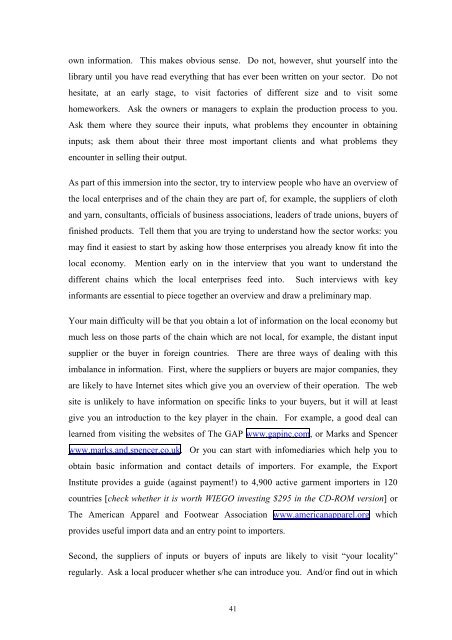McCormick+Schmitz Handbook for value chain research on - PACA
McCormick+Schmitz Handbook for value chain research on - PACA
McCormick+Schmitz Handbook for value chain research on - PACA
You also want an ePaper? Increase the reach of your titles
YUMPU automatically turns print PDFs into web optimized ePapers that Google loves.
own in<str<strong>on</strong>g>for</str<strong>on</strong>g>mati<strong>on</strong>. This makes obvious sense. Do not, however, shut yourself into the<br />
library until you have read everything that has ever been written <strong>on</strong> your sector. Do not<br />
hesitate, at an early stage, to visit factories of different size and to visit some<br />
homeworkers. Ask the owners or managers to explain the producti<strong>on</strong> process to you.<br />
Ask them where they source their inputs, what problems they encounter in obtaining<br />
inputs; ask them about their three most important clients and what problems they<br />
encounter in selling their output.<br />
As part of this immersi<strong>on</strong> into the sector, try to interview people who have an overview of<br />
the local enterprises and of the <str<strong>on</strong>g>chain</str<strong>on</strong>g> they are part of, <str<strong>on</strong>g>for</str<strong>on</strong>g> example, the suppliers of cloth<br />
and yarn, c<strong>on</strong>sultants, officials of business associati<strong>on</strong>s, leaders of trade uni<strong>on</strong>s, buyers of<br />
finished products. Tell them that you are trying to understand how the sector works: you<br />
may find it easiest to start by asking how those enterprises you already know fit into the<br />
local ec<strong>on</strong>omy. Menti<strong>on</strong> early <strong>on</strong> in the interview that you want to understand the<br />
different <str<strong>on</strong>g>chain</str<strong>on</strong>g>s which the local enterprises feed into. Such interviews with key<br />
in<str<strong>on</strong>g>for</str<strong>on</strong>g>mants are essential to piece together an overview and draw a preliminary map.<br />
Your main difficulty will be that you obtain a lot of in<str<strong>on</strong>g>for</str<strong>on</strong>g>mati<strong>on</strong> <strong>on</strong> the local ec<strong>on</strong>omy but<br />
much less <strong>on</strong> those parts of the <str<strong>on</strong>g>chain</str<strong>on</strong>g> which are not local, <str<strong>on</strong>g>for</str<strong>on</strong>g> example, the distant input<br />
supplier or the buyer in <str<strong>on</strong>g>for</str<strong>on</strong>g>eign countries. There are three ways of dealing with this<br />
imbalance in in<str<strong>on</strong>g>for</str<strong>on</strong>g>mati<strong>on</strong>. First, where the suppliers or buyers are major companies, they<br />
are likely to have Internet sites which give you an overview of their operati<strong>on</strong>. The web<br />
site is unlikely to have in<str<strong>on</strong>g>for</str<strong>on</strong>g>mati<strong>on</strong> <strong>on</strong> specific links to your buyers, but it will at least<br />
give you an introducti<strong>on</strong> to the key player in the <str<strong>on</strong>g>chain</str<strong>on</strong>g>. For example, a good deal can<br />
learned from visiting the websites of The GAP www.gapinc.com, or Marks and Spencer<br />
www.marks.and.spencer.co.uk. Or you can start with infomediaries which help you to<br />
obtain basic in<str<strong>on</strong>g>for</str<strong>on</strong>g>mati<strong>on</strong> and c<strong>on</strong>tact details of importers. For example, the Export<br />
Institute provides a guide (against payment!) to 4,900 active garment importers in 120<br />
countries [check whether it is worth WIEGO investing $295 in the CD-ROM versi<strong>on</strong>] or<br />
The American Apparel and Footwear Associati<strong>on</strong> www.americanapparel.org which<br />
provides useful import data and an entry point to importers.<br />
Sec<strong>on</strong>d, the suppliers of inputs or buyers of inputs are likely to visit “your locality”<br />
regularly. Ask a local producer whether s/he can introduce you. And/or find out in which<br />
41














